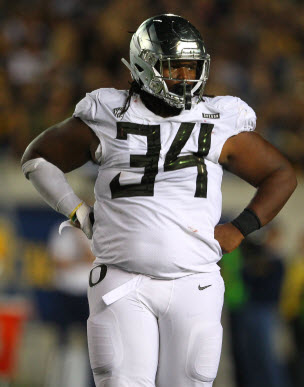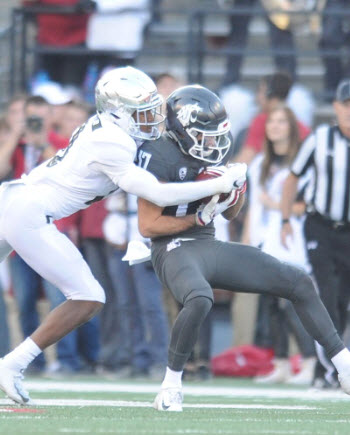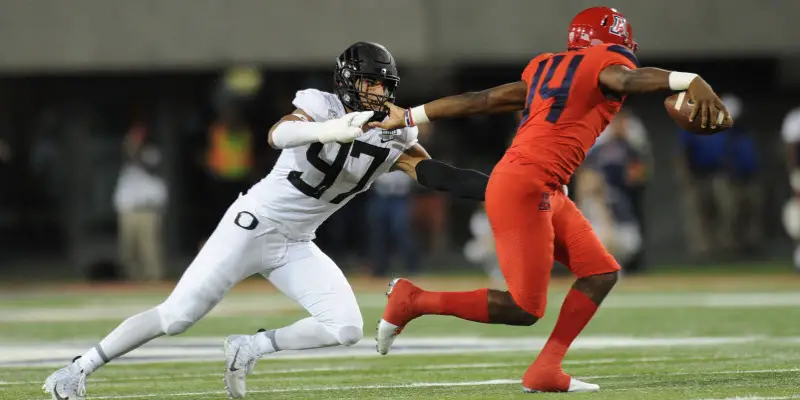It’s been a rough couple of weeks for Oregon fans. As if a failed comeback attempt in the midst of a 27-point deficit against Washington State wasn’t painful enough, the following week Arizona shellacked the Ducks 44-15.
There are plenty of reasons that the Ducks find themselves staring at a potential three-game losing streak, but chief among them is their defense’s uninspiring play. The Ducks have been taken to the woodshed by offenses built with low-ranking recruits. Now they face the prospect of slowing down a UCLA offense led by Chip Kelly, one of the best offensive innovators the sport has ever seen.
With four games left, there’s still time for the Ducks to right the ship. But that prospect is looking grimmer by the second, with the way the Ducks’ defense has been playing.
Fans Hoped the Ducks’ Defense Would Break Out in 2018
Coming off the heels of the 2017 season that saw the Ducks’ defense go from atrocious to serviceable, fans expected an even bigger progression this year in defensive coordinator Jim Leavitt’s second season. After all, Leavitt had previously transformed a putrid Colorado defense. If success was possible at Colorado of all places, surely Leavitt would fare better at Oregon with a bevy of former blue-chip recruits at his disposal.

Jordon Scott has proven to be an effective run defender.
He inherited a talented roster, full of players who have flashed elite potential. Defensive building blocks Jalen Jelks, Troy Dye, Jordon Scott, Justin Hollins and Ugo Amadi have each played at an all-conference level. While they haven’t always been consistent, there’s no question that the Ducks’ defense has premier talent at a number of positions.
Last season, it looked like the Ducks’ defenders were finally realizing their potential. They were noticeably more disciplined and physical than they had been in any year under former head coach Mark Helfrich. They made their share of mistakes, but fans largely attributed that to inexperience.
With most of the roster returning entering this season, and with Leavitt’s reputation as a top-notch defensive mind, everything pointed towards another big step forward for the defense. Unfortunately, it has regressed.
The Ducks’ Defense Has Gone in Reverse
Somehow, despite this year’s unit possessing many of the same pieces as last year’s decent iteration, this version of the Ducks’ defense is bordering on disastrous.

Washington State’s receivers had a field day against the Oregon secondary.
The secondary has been a mess. Little-known Bowling Green wide receiver Scott Miller torched the Ducks’ defense with 13 receptions for 166 yards and two touchdowns. Stanford quarterback KJ Costello threw for 327 yards on only 26 attempts and earned a QBR of 95.3. And Washington State quarterback Gardner Minshew launched himself into Heisman consideration with his 323-yard, four-touchdown performance against the Ducks. A few breakdowns in coverage are understandable, but the Ducks’ secondary is getting gashed on a weekly basis.
The rushing defense hasn’t fared much better. Yes, the Ducks played relatively well against Bryce Love and company, but Stanford hasn’t been able to run the ball against anyone. Outside of the Stanford game, the Ducks haven’t looked particularly impressive against any of their conference opponents’ rushing attacks. They saved their worst performance for last Saturday, surrendering 276 yards to a seemingly overmatched Arizona offensive line and a gimpy Khalil Tate.

Oregon’s defense has been rough to watch.
Optimists may note that statistically, the Ducks are right about where they were last season in terms of total defense (379.5 ypg allowed this season and 369.2 ypg allowed in 2017) and scoring defense (28.4 ppg allowed this season and 29.0 ppg allowed in 2017). However, a look at the advanced metrics shows that these numbers are fools’ gold.
Bill Connelly’s S&P+ rating grades teams on their performance relative to their competition, by measuring opponent-adjusted efficiency, explosiveness prevention and field position surrendered. It provides a more accurate picture of how well each team is performing against its schedule than the conventional numbers. Needless to say, the S&P+ analytics aren’t as kind to the Ducks. Last season, the Ducks’ defense ranked 61st in defensive S&P+ — not perfect, but not awful. This season, the Ducks have dropped a whopping 15 slots, ranking 76th.
It’s clear the Ducks’ defense has not been the dominant force that fans had hoped for. Instead, it has been a liability, and has put the Ducks in serious danger of ending the season with a monumental collapse.
Oregon’s Offense Depends On a Quality Defense
Many blame the Ducks’ recent struggles on the lack of consistency of their new offensive scheme. And while the offense has had its share of issues, it’s difficult for almost any offense to succeed with a defense that gives up first downs like raffle tickets.
Each side of the ball complements the other, and the Ducks’ new offense is particularly dependent upon a quality defense to operate to its full potential. The goal of the offense is to use a downhill, physical rushing offense to control the pace of the game and wear down opposing defenses.

A third string running back found success against Oregon’s defense.
An efficient rushing offense, matched with vertical shots and play action in the passing game, can be a devastating strategy, so long as the defense is able to contain the opposing offense and avoid falling into multi-touchdown deficits. However, when the defense gives up boatloads of points, especially early on, it’s very difficult for the Ducks to stick to a methodical, ground-based approach and keep pace with the opposing offense.
In their losses against the Cougars and the Wildcats, the Ducks’ offense never had a chance. Yes, they got off to slow starts offensively, but in either game, by the second quarter, the Ducks had to abandon their running game and attempt north of 40 passes just to have a chance.
It’s fair to surmise that Oregon would be better off with a more diverse offense, but the reality is that the offense isn’t changing any time soon. With that being the case, the defense needs to play up to its potential and keep games within reach, especially against offenses that aren’t exactly composed of elite talent.
With just four games left, the Ducks will need to shore things up defensively if they want to end this shocking losing streak. If they don’t, results like the blowout loss last week will become the norm rather than the exception.
Joshua Whitted
Morgantown, West Virginia
Top Photo by Tom Corno
Give us your thoughts after the game Saturday night as an article will be published an hour and a half after the game for the purpose of having a forum (through the comments) to discuss the UCLA contest. Charles Fischer
Related Articles:
Joshua is an adopted Duck fanatic, originally hailing from southwestern Pennsylvania. His love for the University of Oregon began as a young child when he became mesmerized by the flashy uniforms and explosive offenses of the Chip Kelly era, and now, he follows the team religiously. His fondest memory of the team is seeing De’Anthony Thomas race past Wisconsin defenders back in the 2012 Rose Bowl. A true football enthusiast, Joshua loves studying the intricacies of the game, and he aspires to become a professional sports journalist. Joshua now resides in Morgantown, West Virginia where he works in customer service. When he’s not watching Oregon replays, Joshua loves reading, writing, and spending time with his family. Contact: whittedjd@gmail.com


